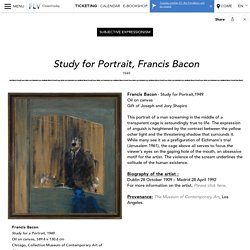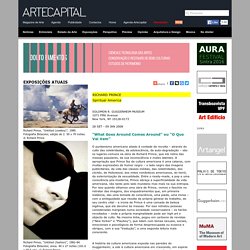

Introducao a Analise da Imagem Martine Joly. Martins celia 2013 01 25. Study for Portrait Francis Bacon. Francis Bacon - Study for Portrait,1949 Oil on canvas Gift of Joseph and Jory Shapiro This portrait of a man screaming in the middle of a transparent cage is astoundingly true to life.

The expression of anguish is heightened by the contrast between the yellow ocher light and the threatening shadow that surrounds it. While many see it as a prefiguration of Eichmann’s trial (Jerusalem 1961), the cage above all serves to focus the viewer’s eyes on the gaping hole of the mouth, an obsessive motif for the artist. Biography of the artist : Dublin 28 October 1909 – Madrid 28 April 1992 For more information on the artist, Please click here. Provenance: The Museum of Contemporary Art, Los Angeles. Brasil - Revista - Artes e arquitetura - Goethe-Institut
Richard Prince by Marvin Heiferman. Richard Prince, 1988.

All photographs courtesy of Barbara Gladstone Gallery. Marvin Heiferman I wanted to talk about abstraction, the idea that your works seem truly abstract and always have. I think that’s part of why everyone’s been so perplexed and confused about the work—for ten years—they didn’t know what they were looking at. They were pictures but didn’t look like pictures. They’re not factual, not quite fantasy. STUDIUM 6. Mauricius Martins Farina. Docente do Departamento de Multimeios/IA/UNICAMP. Áreas de Interesse Midialogia.

Fotografia. Semiótica. Artes Visuais. Spiritual America. Spiritual America SOLOMON R.

GUGGENHEIM MUSEUM 1071 Fifth AvenueNew York, NY 10128-0173. Photographer Sam Abell Talks about “Cheeky” Richard Prince After Prince Sold His Photo for Millions. Abell’s iconic photo and Prince’s “artistic” crop of it.

Source: PhotoShelter Before Richard Prince appropriated the photos of Instagram users, and long before the SuicideGirls re-appropriated their photos, the lazy “artist” became famous for stealing re-photographing Sam Abell’s iconic cowboy photos. Prince took cigarette ads with Abell’s Marlboro Man images and photographed them in a way that basically “cropped” the text and logo out.
R10 3690 1. John Berger / Ways of Seeing , Episode 1 (1972) Dias estranhos vistos de perto. Coletiva fotográfica na Galeria de Arte do IA/UNICAMP. “Dias estranhos vistos de perto.” conta com a participação de vários artistas que trabalham com mídias e suportes diversos: pintura, desenho, vídeo, fotografia, objeto, instalação e gravura.

Luis Camnitzer: La Corrupción en el Arte / El Arte de la Corrupción. El Síndrome de Marco Polo. Un día muy preciso, hace ya cuarenta años, comprendí cabalmente la obviedad de que la misma obra de arte que cumplía con mis propósitos como artista era, simultáneamente, un objeto comercial.

Era todavía un estudiante de arte y en esa época se nos enseñaba hacer "arte" (académico y desconectado de la vida real) y no negocios, y el mercado me era tanto una utopía como la revolución social. A pesar de la distancia de las ventas (no totalmente salvada hasta el día de hoy), desde el momento que me golpeó esa realización tuve pánico con respecto a la negociación de mi trabajo. No lo fue porque no me interesara el dinero, o porque considerara que mi obra era demasiado "pura" para el comercio. Sociedadespec. Aleph · [ pensamiento ] Fotomontaje y género: el caso de Barbara Kruger. Cut-up technique. The cut-up technique (or découpé in French) is an aleatory literary technique in which a text is cut up and rearranged to create a new text.

The concept can be traced to at least the Dadaists of the 1920s, but was popularized in the late 1950s and early 1960s by writer William S. Burroughs, and has since been used in a wide variety of contexts. Technique[edit] The cut-up and the closely associated fold-in are the two main techniques: Cut-up is performed by taking a finished and fully linear text and cutting it in pieces with a few or single words on each piece. History in literature[edit] A precedent of the technique occurred during a Dadaist rally in the 1920s in which Tristan Tzara offered to create a poem on the spot by pulling words at random from a hat.
William Burroughs cited T. Gil J. Also in the 1950s, painter and writer Brion Gysin more fully developed the cut-up method after accidentally re-discovering it. Gysin introduced Burroughs to the technique at the Beat Hotel. Richard Prince - Cowboys. Colección de Arte del Banco de la República. 3umbral. Debray_Regis_Vida_y_Muerte_de_la_Imagen. The Clock - Christian Marclay. The Clock by Christian Marclay is an audiovisual work lasting 24 hours.

Spectacular and hypnotic, its cinematographic mechanism is regulated with a clockmaker’s precision, and turns into a time machine, marking a century of cinema minute by minute. Here Christian Marclay orchestrates thousands of film excerpts taken from the entire history of the cinema to compose this mechanism, which tells the time in real time in all the venues that exhibit it. With a mix of comedies in black and white, B films, avant-garde films and thrillers, passing time is made visible through successive shots of clocks, alarm clocks, watches, actions and dialogues illustrating the implacable march of time. Christian Marclay has always used the cinema as a repertory of sample excerpts. This work was one of the events in the 54th Venice Biennial in 2011, when Christian Marclay was awarded the Golden Lion for the Best Artist.
Danto Arthur C. Después del fin del arte. El arte contemporáneo y el linde de la historia.